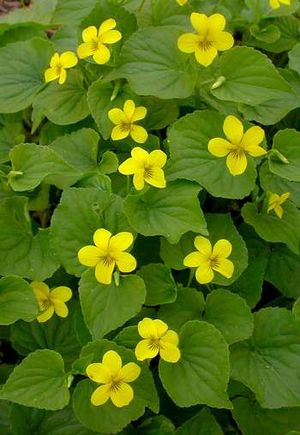Viola glabella
- Latin Name: Viola glabella
- Family: Violaceae
- Common Names: stream violet, yellow wood violet, pioneer violet
- Codon: VIOGLA
Contents
Taxonomy
| Viola Glabella | |
|---|---|
| Scientific classification | |
| Kingdom: | Plantae |
| Subkingdom: | Tracheobionta |
| Phylum: | Spermatophyta |
| Subphylum: | Magnoliophyta |
| Class: | Magnoliopsida |
| Subclass: | Rosanae |
| Order: | Malphigiales |
| Family: | Violaceae |
| Genus: | Viola L. |
| Species: | Viola Glabella L. |
Description
General: Puberulent perennial from widely spreading, scaly, fleshy rhizomes, the flowering stems 5-30 cm. tall, leafless the lower two-thirds.
Leaves: Leaf blades ovate-cordate to reniform, abruptly pointed, the basal leaves with petioles 10-20 cm. long; stipules membranous, ovate to obovate, 5-10 mm. long, entire.
Flowers: Flowers 8-14 mm. long, borne chiefly on the upper part of the stem, on peduncles about as long as the leaves; spur very short; petals clear yellow, the lower 3 with purple penciling, the lateral pair well bearded; style head copiously bearded.
Fruit: Fruit a 3-valved capsule, ovary superior, placentation parietal, seeds brown.[1]
Bloom Period
Flowering
Time: March-July [1]
Crop Intervals: Perennial
Distribution
Both sides of the Cascades in Washington, Alaska to California, east to Montana[2]
Habitat
Moist woods and stream banks, low to mid-elevations in the mountains.
Propagation
Stream violet is easy to establish in woodland gardens. It may reseed and can become somewhat weedy.
References
Image Gallery
Image:
- ↑ 1.0 1.1 WTU Herbarium, Burke Museum, & University of Washington. (n.d.). Retrieved from https://biology.burke.washington.edu/herbarium/imagecollection/taxon.php?Taxon=Viola glabella
- ↑ Hitchcock, C., Cronquist, Arthur, Giblin, David, Legler, Ben, Zika, Peter F., Olmstead, Richard G., . . . Porcino, Natsuko. (2018). Flora of the Pacific Northwest : An illustrated manual (Second ed.). Seattle: University of Washington Press ; Burke Museum of Natural History and Culture.

